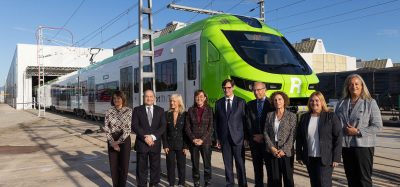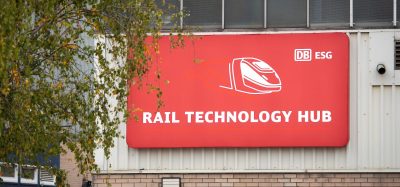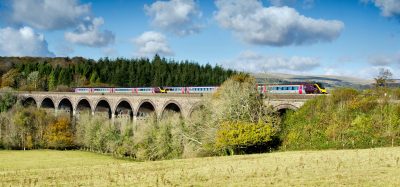Navigating rail freight’s future: Challenges and opportunities unveiled
Posted: 7 August 2024 | Kathryn Oldale - DB Cargo UK | No comments yet
At Rail Live 2024, Kathryn Oldale, Head of Strategy, Policy and Communications at DB Cargo (UK) Limited, sat down with Global Railway Review’s Emily Budgen to discuss the future of rail freight, focusing on industry challenges, technological innovations and sustainability efforts.
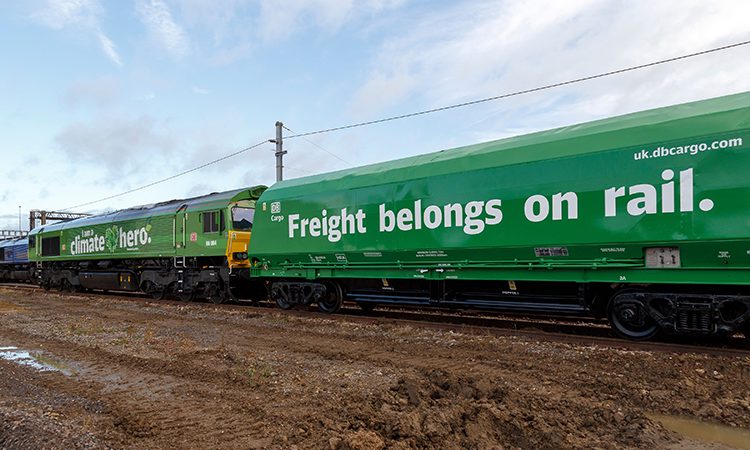

Credit: DB Cargo UK
Kathryn, what was your route into rail?
I never thought about a career in rail and that’s something I’d really like to change for others. I’d like more young people, particularly graduates, school leavers or people just wanting a career change, to think about rail”
It’s quite an interesting one really. I didn’t start in rail, I actually started in global orthopaedics at Johnson & Johnson. So quite different when you’re talking about hips and knees and various products for the human body versus coal and steel coil and aggregates. I spent quite a while at Johnson & Johnson and then I was headhunted into rail.
I never thought about a career in rail and that’s something I’d really like to change for others. I’d like more young people, particularly graduates, school leavers or people just wanting a career change, to think about rail. This is why it’s really important to me that we modernise the industry and we get more tech savvy with what we do. I think people consider rail as boring and dirty but it’s not, it’s really not – despite the fact that we’re walking around in high-vis today! What we do is really cool. I’ve been in rail at DB Cargo UK for eight years and I absolutely love our business, I love the industry. Some of the best people I’ve ever worked with are in the rail industry.
What is the biggest challenge currently facing the rail industry?
Without doubt, cost is the biggest challenge currently facing the rail industry. Specifically, the cost of rail versus road. Through COVID there was, , an HGV driver crisis. So, lots of people trained. They left jobs as bus, ambulance and taxi drivers and retrained as HGV drivers and now, the market is saturated with HGV drivers. Consequently, because of this, road is able to offer unnaturally low- box and container movement prices. It’s undercutting what we can offer so it’s not necessarily that rail is unnaturally high, but that road is unnaturally low.
In addition, you have things like port charges which are totally unregulated. Some ports are putting their rates up overnight, which we and our customers can’t absorb. This is not across the board, however. In fact, some ports are doing great things right now. For instance, DP World in Southampton have a mode shift scheme to promote the use of rail freight. There’s great carbon savings for the port, there’s the economic benefit to the end user for the scheme, getting money for moving their product by rail and road, and there’s the benefit that we receive as operators of moving more containers by rail. So, there are isolated pockets of innovation, but we really need to tackle the road versus rail cost right now.
What’s an innovation that you’d particularly like to see?
One thing that we absolutely need to do is to promote rail freight to every single member of the Great British public. Every single person uses rail freight, they just don’t know it. Whether it’s things like fruit and vegetables in fridges or wine in cupboards or your car on your drive, it’s only possible because of rail freight. A great example is fresh produce coming from Spain and being brought to supermarkets all across the UK by rail. One thing that I want to do is to promote the benefits, importance and use of rail freight to public consumers.
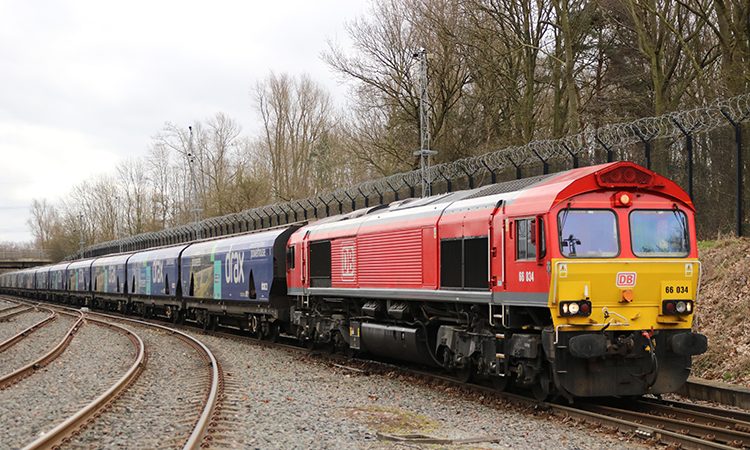

Credit: DB Cargo UK
You talked about the 75% growth target set by the UK government. That sounds really promising. Do want to elaborate?
So, if you look at incremental organic growth year-on-year of our sector, 75% is more than achievable. We could probably double, we could get to 100% by 2050 just through natural organic growth with our existing customer base. But when you look at what else is out there, there’s a pure opportunity for modal shift. Through containers, existing and emerging markets like parcels and green fuels, sustainability assets, batteries, hydrogen, carbon capture and storage, there’s so much potential for us to blow the 75% target out of the water.
We originally lobbied for a trebling of rail freight growth as a target. We didn’t get that, we got 75%. I’m not going to complain because it’s the first time ever in the UK that we’ve had a freight growth target. So, from an optics perspective 75% is better than nothing, but is it ambitious enough? I’d say, categorically not.
How much potential is there for more sustainable alternative fuels to be carried by freight?
The new government will have to look at clean, green domestic energy as an absolute priority”
I think there’s huge potential for us, but it’s an area in this country that we’ve not yet delved into, and I think that the new government will have to look at clean, green domestic energy as an absolute priority. We’ve all suffered through increased costs of energy over the past few years, through COVID and the invasion of Ukraine, because we’re so reliant on international and foreign energy production. If the UK government can focus on domestic energy production, we can then look at how we can dovetail into that. We should look to invest in things like solar, water, wind, hydrogen, carbon capture and storage, movement of carbon, storage of carbon. Rather than investing wholesale in pipelines, we will look at how rail freight can support that. There are manufacturers in the UK that want to use carbon dioxide as part of their supply chain. Manufacturers, for example, need carbon dioxide, so how can we look at removing it from highly carbon emitting manufacturing processes and then move it to industries that want to use it. We’ve got a lot to do, but I believe rail freight can deliver a solution to the emerging clean energy markets in the UK.
Is there a need for a more direct and blunt approach for the public about rail and freight and how much they use it? And does freight need to be glamorised? If so, would that also help with training schemes and encouraging people to go into the rail industry because they think it’s an exciting career?
Absolutely! There’s one emerging scheme, the ETCS scheme –which I think this could revolutionise our sector and make it more appealing to a totally different demographic of professional and dare I say it – make rail sexy!.
We need a broad approach when it comes to benefits of rail freight. There so many consumers who do not understand how we directly benefit them and their lives. It’s not just about what we offer in terms of cars on drives or houses being built or products that directly affect day to day life. It’s also educating consumers on things like air quality; one train takes 129 trucks off the road. When you think about all those HGVs that aren’t on the road because the freight is being transported by rail, it’s a significant reduction in harmful emissions and huge benefit to air quality.
I think there’s also opportunities to look at transport safety as well, it’s making our roads safer by not having trucks on them for the longer stretches. Our debate shouldn’t focus solely on rail versus road, we need to look more holistically about the best use of the assets we have available to us and how do we get the benefit from rail and road together?
If you’re looking at best utilisation of assets, consider one train compared to 129 trucks. That’s 129 truck drivers and trucks that you can use on first- and last-mile, reaping all the benefits associated with an efficient transport system – economically, environmentally and most importantly, safety.
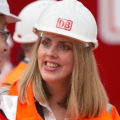

Stay Connected with Global Railway Review — Subscribe for Free!
Get exclusive access to the latest rail industry insights from Global Railway Review — all tailored to your interests.
✅ Expert-Led Webinars – Gain insights from global industry leaders
✅ Weekly News & Reports – Rail project updates, thought leadership, and exclusive interviews
✅ Partner Innovations – Discover cutting-edge rail technologies
✅ Print/Digital Magazine – Enjoy two in-depth issues per year, packed with expert content
Choose the updates that matter most to you. Sign up now to stay informed, inspired, and connected — all for free!
Thank you for being part of our community. Let’s keep shaping the future of rail together!



